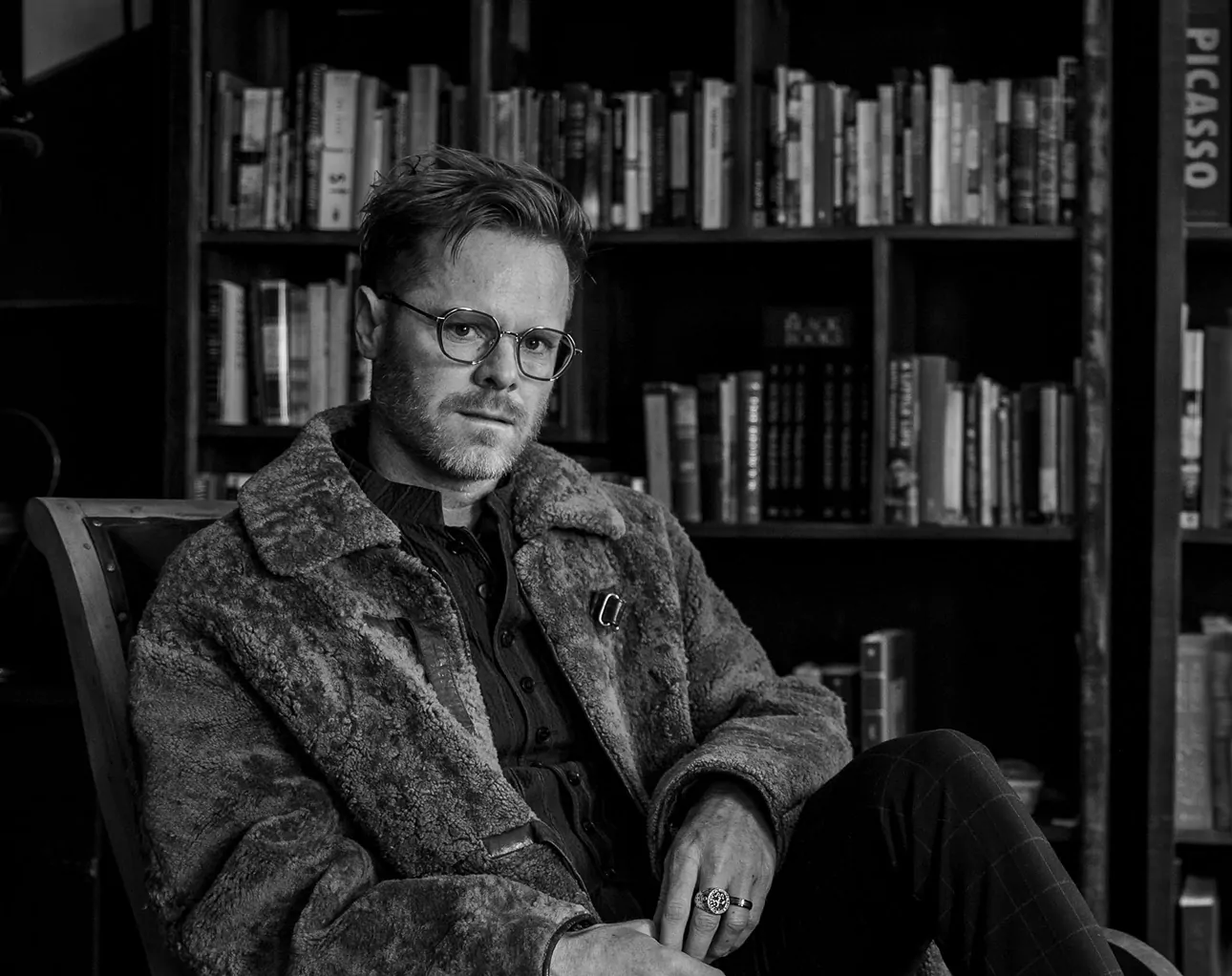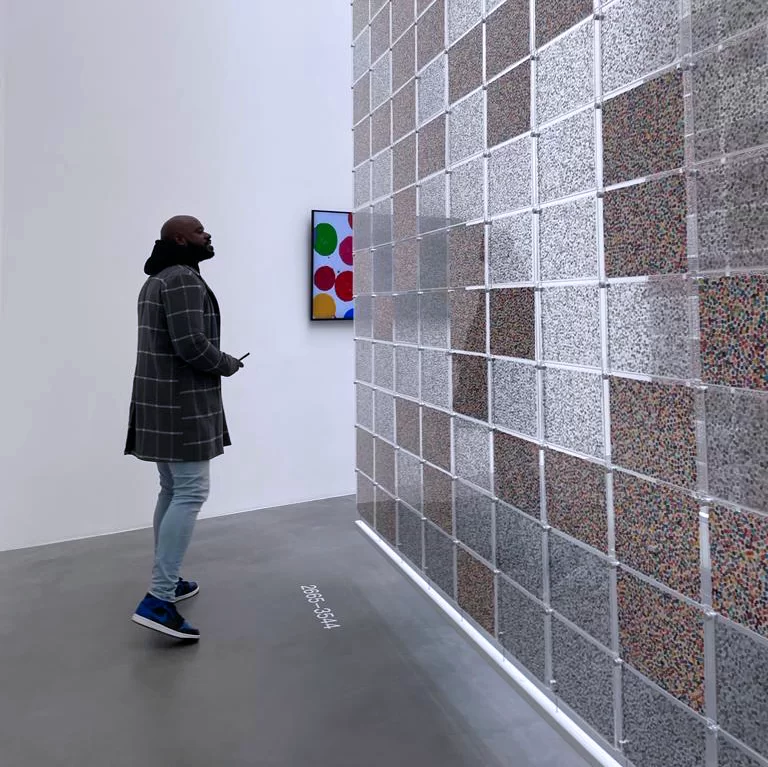From Confrontation to Contemplation, Joshua Hagler’s Journey into the Desert—and His Emergence as Æmen Ededéen—Marked a Turn Toward Silence, Symbol, and a Deeper Vision of What Art Is For
For years, the work of Joshua Hagler was charged with urgency—political, confrontational, loud in the way a country sometimes needs its artists to be. But a shift occurred. After relocating to the high desert of New Mexico in 2018, he shed not only a city but a name, emerging as Æmen Ededéen and turning his focus inward. The change was far from cosmetic. It signalled a deep reconsideration of what art is, and what it’s for.
“What if meaning isn’t something you declare,” he now asks, “but something you uncover? What if art is a way of remembering what you forgot you knew?”
His latest body of work, The Glass Dream Game, shown in April at Art Brussels in Maruani Mercier’s stand, unfolds like a ritual. Each painting begins with a selection of six books from his personal library, chosen at random. From those pages, a kind of intuitive code emerges—a hexagram, a pattern, a story. From the story, a vision. Painting, for Ededéen, is no longer an act of expression. It is an act of reception.
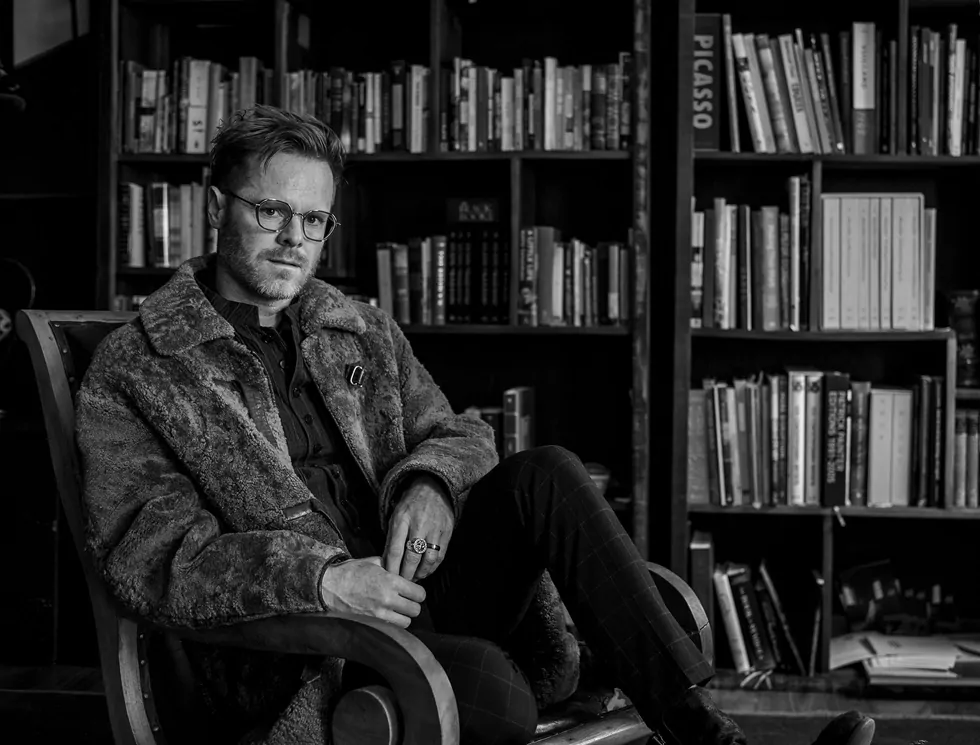
Courtesy of the artist and MARUANI MERCIER
So, with The Glass Bead Game, I had a hunch that simply reading it might offer insight into how I could begin formulating a system of my own
Æmen Ededéen (Joshua Hagler)
Born on an Air Force base in Idaho and raised amid the charged contradictions of evangelical America—rural Illinois, Arizona, and later California—Hagler’s work has always existed at the fault lines between belief and doubt, dogma, trauma, and transcendence. If his earlier work sought to interrogate power from the outside, The Glass Dream Game seeks to disarm it from within.
These new works reflect a broader cultural mood: the fragmentation of identity, the blurring of truth, and a deepening hunger for meaning in an increasingly chaotic world. But instead of offering commentary, Ededéen offers something more: a space to reflect, to ask, to not know. “In the past, I made political work to confront the culture,” he says. “Now, I see it was also a way to avoid confronting myself.”
Using a process that blends bibliomancy (divination by books), archetypal patterning, dream-logic storytelling, and layered, textured painting, The Glass Dream Game is part system, part ceremony. The result is a four-part framework—Hexagram, Trial, Dream, Vision—that treats art not as explanation, but more as excavation. A search not for clarity, but for resonance.
At Art Brussels, the game unfolded as a series of paintings where Tarot cards collide with Philip Guston, and spectral forms drift through compositions that feel both ancient and futuristic.
The work doesn’t shout. It doesn’t resolve—it reveals. “I don’t want enemies in order to know who I am,” the artist says. “I don’t want to live like that.”
In the tranquil plains of New Mexico, far from the ideological extremes of the coasts, Ededéen is shaping something rarer than consensus: a vocabulary of vision. One that embraces mystery, honours intuition, and opens a door—however slightly—to the unknown.
We spoke with him after his presentation at Brussels to discuss the evolution of his practice, the symbolic architecture of The Glass Dream Game, and why, these days, he’s more interested in listening than speaking.
Your work often explores what you call the “violence of the mind”—the way narratives are imposed to create enemies. How has this idea evolved in your current series, The Glass Dream Game?
Æmen Ededéen (Joshua Hagler): When I was writing about and engaging with that in my work some years ago, I was referring to the way in which we project our shadows onto the other in order to create and reinforce our own identity and separateness. We want somewhere for our traumas, insecurities, disappointments, and brokenness to land. We also want to eliminate competition in order to achieve our goals. These are all tendencies I have had for most of my life, yet it’s only in recent years that I’ve become aware of their depth and significance.
The harder it becomes to find joy in life, the more enemies we pin to a mental ledger of our own making. On one level, we want someone to blame. We’re angry because we’re lonely. No one understands what we’re going through, and it’s painful to feel unseen. We’re lonely because we can’t find meaning or significance in our individual lives, except in relation to what culture dictates, celebrates or penalises—or how we imagine others imagine us.
When others’ suffering doesn’t seem to take account of our own, we imagine that other as a malicious, ignorant opposite. That opposite becomes a rallying point behind which we assemble an identity we assume to be inherently good, since their identity is assumed to be inherently bad. Our so-called good identity becomes hollow, defined only in opposition. We swim in the abstraction of the other and anchor ourselves to nothing real.
We fail to see that the other we project upon has become a mere object; we become dependent on them to define who we are, on their image to inflate our own sense of moral superiority, and to justify our worst instincts. What if most of what we believe about the other is a lie we tell to avoid facing what we don’t want to know about ourselves? And what does that suggest about who we think we are? How willing are we to ask difficult questions about the “good” we supposedly do?
At this stage in life, I no longer want a violent mind. When I see and accept my own brokenness, I begin to surrender one false idea after another. I do not want enemies in order to know who I am. I don’t want to live like that.

The Academy of Forbidden Thoughts, 2024
mixed media with glass beads on canvas
Diptych: each painting : 193 x 167.6 cm | 76 x 66 in (AE/8)
Courtesy of the artist and MARUANI MERCIER
This is where, after years of making political art (2006–18), I experienced a personal crisis which exposed so much of what I had been avoiding in myself—namely, that many of my ideas and ambitions were quite shallow, and ultimately, more than a little ironic. I had to endure the feeling of inner humiliation. Nihil (2020–24) was the project I undertook across the New Mexico landscape in response to that crisis. The tenets I created, and the tree-shaped route I followed through the state, became a kind of ritual or pilgrimage—an effort to work through this material, to confront myself in the land and in the abandoned places where I installed work.
When that came to an end, I was left with a kind of inner knowing I hadn’t had before—or hadn’t properly valued or prioritised. After four years of working in this way, I began to wonder whether this engagement with difficult unconscious material could be reformulated into a consciously symbolic system. The Glass Dream Game, which I began late last year, proceeds from that question.
At Art Brussels, your booth presents a project inspired by Hermann Hesse’s The Glass Bead Game and structured around the I Ching. What drew you to this intersection of mysticism, scholarship, and chance?
Æmen Ededéen (Joshua Hagler): You know, I think I’ve been drawn to those things all my life. I was always such a strange little kid. I have very early memories of asking certain kinds of questions: how could I be sure whether something was near or far, big or small? Why did explanations so often feel false? I think all children are mystics before we cut them off from that part of themselves. My four-year-old daughter shows all the same proclivities. She carries a secret she doesn’t yet know she knows, which I believe she’ll develop and cultivate over the course of her life.
Mysticism is a deeply important process of questioning and opening—a form of knowledge we carry within us, each of us, if we choose to embrace it. The fact that we even have a word for it—that it exists as a separate category from simply being—says more about the spiritual impoverishment of the culture, I think, than it does about spiritual life itself.
I’ve been reflecting on how Nihil was only possible because of the way the composer Arvo Pärt structured and approached his music. I’d been looking for a way to create structure that could replace my old habits of conscious message-making. I felt there was nothing worth “saying” anymore—and that even if I had something to say, what would be the point? Yet Nihil’s structure unlocked a profoundly meaningful world for me, even as I was prepared to sacrifice meaning as a value or as a goal in making art. Because the project succeeded in bypassing my conscious mind, it took on far greater meaning for me than any of my earlier work.
So, with The Glass Bead Game, I had a hunch that simply reading it might offer insight into how I could begin formulating a system of my own. The novel famously never describes the game in detail—a fact which seems to have sparked an entire subculture of scholars and nerds like me to imagine what it might have been like had it existed in the real world, and how it might have functioned.
During Nihil, I began to realise that my collection of images and materials gathered across the landscape represented, through the process of making the artworks, an ongoing encounter with the Unconscious—something not unlike dreaming. All the inner vicissitudes emerge through one’s observations, so that we never truly observe anything without also changing it, without interacting with it. When we really pay attention, we don’t simply observe a thing—we observe observation, which carries a certain residue, a kind of parallax view of what we see and how we see. We invent what we discover. The valences that arise from that tension or dance are unique to each of us, so that within each of us is a universe, just as we exist within the universe.
Over time, I made enough work to begin sensing certain patterns—between paintings, for instance. Certain archetypes seemed to pull the work along and emerge within it somehow. Initially, I didn’t want to deal with symbolism in Nihil, but I left behind a trail of work laden with symbols nonetheless. When that project reached its end, I knew the only next step was to figure out how to create a new method—one that could reliably extract a symbolic order from the Unconscious in the way I had only just begun to do in Nihil.
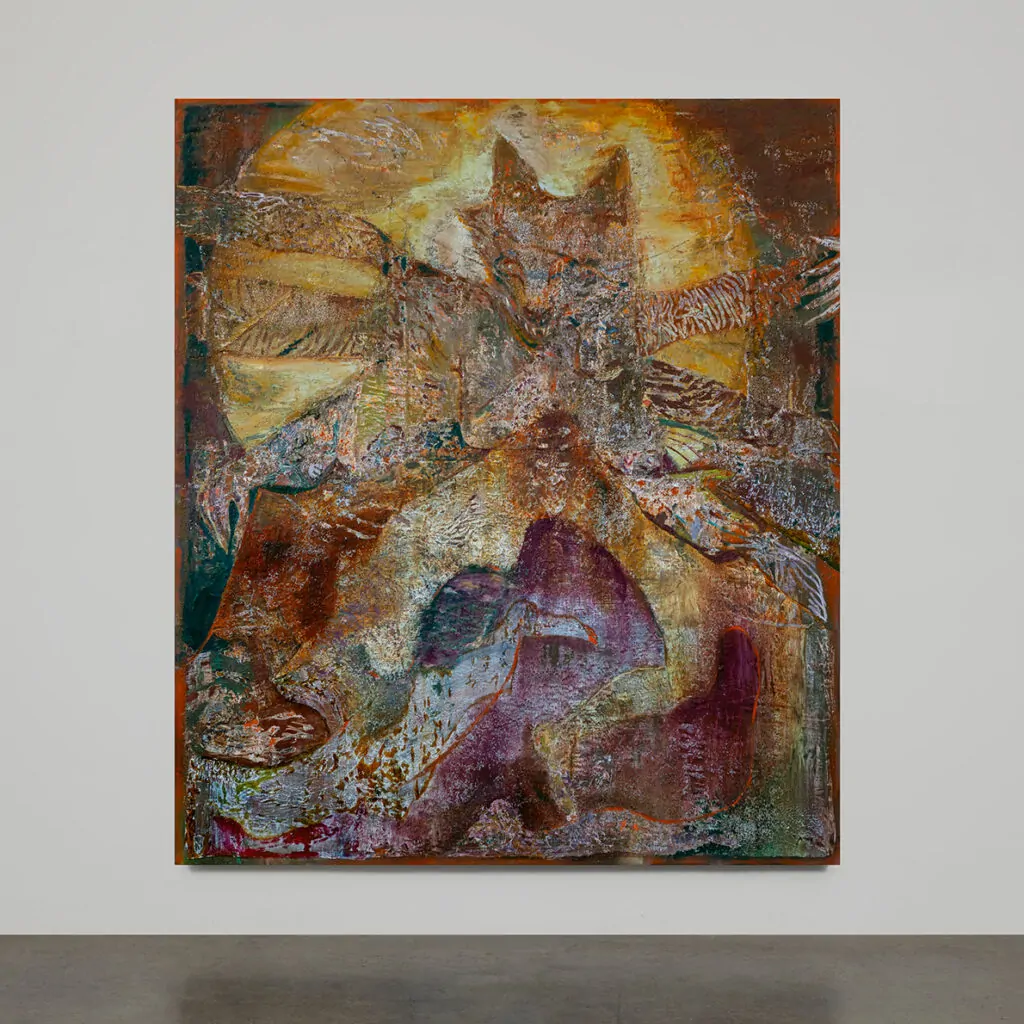
The Three-Legged Jackal Dreamed of Four But Grew Seven Arms and Opened Seven Doors Up Through the Floor and Under the Sun Seven Shining Jackals From Just that One, 2024-25 mixed media with glass beads on burlap and canvas
193 x 167.6 cm 76 x 66 in (AE/7)
Courtesy of the artist and MARUANI MERCIER
Each painting in The Glass Dream Game emerges from six texts or images selected through divination. Do you consider the resulting connections to be revelations, fictions, or something in between?
Æmen Ededéen (Joshua Hagler): The group of six pages—one from each of six books selected at random—is called a Hexagram. My library includes every kind of book: novels, regional guidebooks, graphic novels, history, philosophy, and more. A page might be filled with text, feature images, be blank—or, on one occasion, simply missing, torn out. I look for patterns in what the Hexagram reveals and then try to shift the information or “pieces” around until something begins to take form or gain a sense of specificity. This process of reorganising the material is called the Trial.
I don’t hold fixed beliefs about what the Hexagram means or what the Trial reveals. I only know that each time it feels significant. The sensation is like being in a conversation within imaginal space—there’s what I’m given, and then there’s what I offer in return. A Trial could never unfold the same way twice. Everything influences it: my mood, the weather, how many interruptions occur during the process, and so on. The Game makes no claims, and neither do I. Whatever emerges can be fiction, revelation, or something else entirely. What it means for me will inevitably differ from what it might produce in someone else’s mind—as it should.
I use a simple random number generator on my phone to select the six books that make up the Hexagram from which the work begins. There are almost always uncanny coincidences—what Jung would have called synchronicities—between the pages of completely unrelated books. There are rational explanations for this, to some extent, in terms of how our brains perceive and organise information, but even those explanations mostly just beg the question. If someone were to play the Game themselves, unsettling new questions about reality would almost certainly arise—and they’d have to contend with them in whatever way they could.
I often find myself wondering whether we possess consciousness, or simply participate in it. The Game makes me question that. And the more seriously one takes the question, the stranger—and more compelling—the possibilities become.
There’s something intimate—almost confessional—in using your personal library as source material. Do you view this project as a kind of self-portrait, conscious or unconscious?
Æmen Ededéen (Joshua Hagler): Unavoidably, yes. It’s not a priority for me that I say/show anything about myself, about my own life, in the Game. But I can’t ignore the plain fact that I’ve selected and kept all these books over time, some of them form the time I was a teenager, and that these choices now comprise a library that looks as different from other libraries as my face looks from other faces. So already a boundary and limitation is formed around what I’m able to encounter in the books that I have.
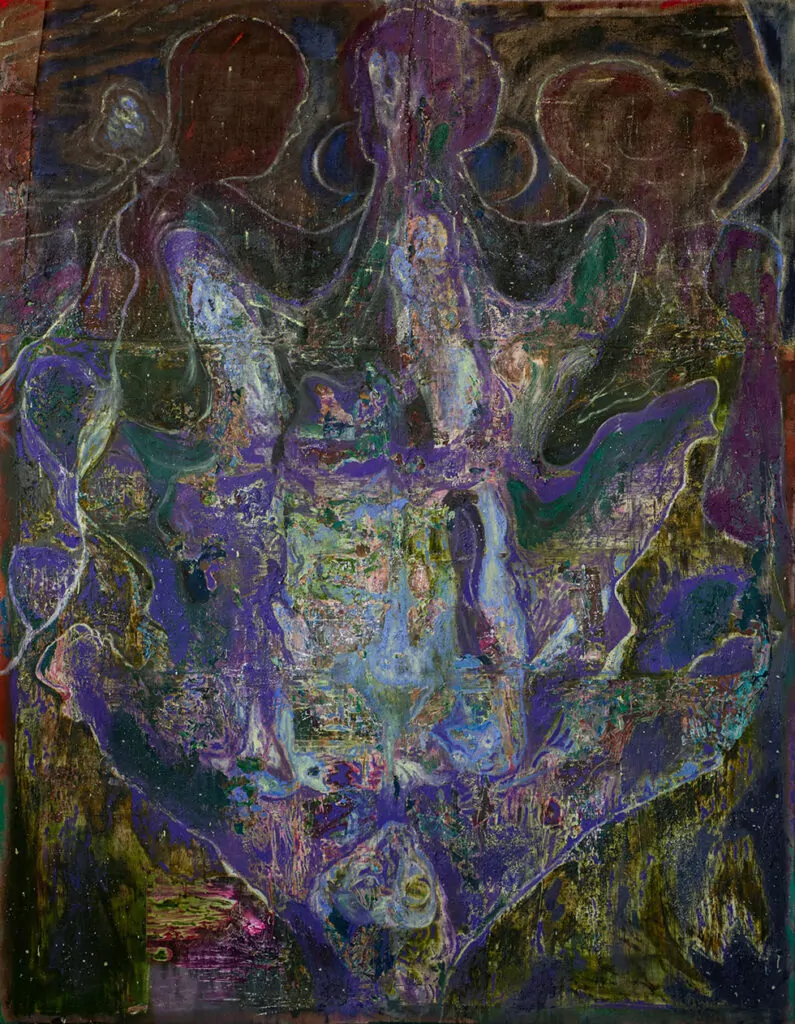
The Clear Water is Mirroring the Clear Sky, 2024
mixed media with glass beads on canvas and burlap
228.6 x 179 cm 90 x 70 1/2 in (JH/3)
Courtesy of the artist and MARUANI MERCIER
The pairing of elements such as Tarot cards and quotations from Philip Guston creates unexpected layers. How do you balance intuition with conceptual structure in these compositions?
Æmen Ededéen (Joshua Hagler): I suppose it’s not really something I think about. Those were strong images that came up in the sixth Hexagram that formed the basis for my painting “The Academy of Forbidden Thoughts.”If cropped just so, they quite clearly fit together, each page from the Guston and Tarot books, the former’s klansmen riding in a car and the latter’s figure on a horse in the Six of Wands. You’ll notice that the Six of Wands came up in the sixth Hexagram? That’s an example of the kind of synchronicity I’m talking about as a regular occurrence in the Game. I did not design it that way.
Anyway, I certainly did see how loaded the imagery was, but I didn’t come into it with anything political of my own to say. I also knew that if I were ever asked about it that it was unlikely I’d be believed, which, for me, only speaks to the power of the Game.
To be honest, I was nervous about this piece because of the controversy a couple years ago around the decision to postpone the Guston exhibition at the National Gallery and the Tate and the rest. I remember all the vitriol being spewed on social media between folks who supported the decision and those who didn’t.
And I made this painting as Trump was campaigning last year. The Six of Wands is to do with success and victory. Now I have that Six of Wands pulling a car full of klansmen in a painting. Given the time I made this painting, what it depicts, and so on, it looks an awful lot like I’m making some kind of statement, one way or another. But truly, those were the images I was given in the process, and I had to make myself make the painting even as I was nervous about how it might be understood. A familiar neurosis of mine.
In reality, a lot of people, maybe a majority, don’t even see the klansmen. Or they see ghosts or something like that, which maybe they are. But the deep love and familiarity I have with Guston’s work is not something everyone shares. When I reflect on the initial decision to postpone the Guston show I wonder if folks would have reacted in the way that was so feared. Symbols and signifiers that can have such powerful meaning for some of us, have no power at all in the imaginations of others. I don’t know if I find that to be a disappointment or a relief.

A Prayer for a Place Where Brokenness Rests, 2024-25
mixed media with glass beads on carpet
193 x 167.6 cm | 76 x 66 in (AE/12)
Courtesy of the artist and MARUANI MERCIER
Your process often involves building up and then scraping away material—sometimes incorporating glass beads or textiles. Is this gesture intended to echo memory, trauma, or the act of forgetting?
Æmen Ededéen (Joshua Hagler): Yes to all of that. A version of this process goes all the way back to 2016, so it’s been almost a decade now since I’ve been interested in excavation. This far predates the Glass Dream Game. Making work in this way perhaps performs forgetting while, at the same time, tries to remember, or to unveil.
This relates back to the Greek ideas of Lethe and Aletheia, a through-line in my work from the earliest experiments with the process. I often have a feeling of digging for something, something felt deep down but so far unrealized. I trust that the process will lead me to recognize what I can’t envision up to that point. That way of working is parallel to the Greek concept of Aletheia, a form of truth emerging out of poetry which recovers deep memory, even, and most importantly, memory which precedes this life.
You’ve cited Jungian psychoanalysis, religious art, science fiction, and cult horror films as influences. What do these seemingly disparate sources offer your artistic language?
Æmen Ededéen (Joshua Hagler): I’m laughing at the version of myself I find in this question. In other words, have I been influenced by almost every damn thing there is over the past twenty years of my career? Yes!
Probably, it’s not so much that these various thingy-things occupy all of my attention like a tourist in a gift shop, as it is that I’m looking for something singular, in the world, within myself, to which all these things partially point to and hint at in their various ways. Why, for example, have I felt so lonely and alienated in the world most of my life? Was I the first person in the world to feel this way? I find the answer is no and the lineage of artists, philosophers, writers and so on attesting to that is a long and deep one. What does Jung have to say about it? How about the world’s religions? What shows up in art history? Horror films…evidently? They offer to my “artistic language” exactly what they offer to my life: direction, possibility, strength.
But if we could encapsulate and enumerate twenty years’ worth of seemingly disparate interests, perhaps the most obvious place to find them is in my personal library. My library, now, is the most important tool I have in creating and playing the Glass Dream Game. I can never know what the pages will give me, but there are always connections which defy rationality. I owe much to Jung in how I’ve gained a sense of permission and courage to make use of these kinds of experiences even as I know they seem unbelievable to many people. So what Jung, Hesse, and the I Ching together have given me, is permission to create my own kind of bricolage, and to trust that the improvisational moves that occur in the Game will lead to something significant and indelible if I only trust the process.
Having grown up between rural Illinois and Arizona, and now living in New Mexico, how have these environments—and the cultural contradictions within them—informed your vision?
Æmen Ededéen (Joshua Hagler): I’ve often discussed the loss of my youngest brother while growing up in Idaho, which was a foundational event rippling out into all areas of my life from then to now. After we moved from there to southern Illinois, I was in middle school and growing up in a conservative Christian environment, which became more fundamentalist over time. What I’ve often left out of the story was the strange inner abundance that almost always accompanied difficult events and experiences. When my brother died, I escaped into worlds of my own making, drawing my own comic books and telling my own stories from a very early age. Because I believed in Heaven, I imagined a fantastical version of Danny capable of doing anything, being anything, and I attached my own unexpressed feelings that basic image. A kind of imaginal reality, a wild twin, embedded itself in my inner life. I even went through a period shortly after Danny’s death in which I began saying everything twice, first in my normal voice, then in a whisper.
As I came into my teens, I grew more aware of the hypocrisies and so on of the church until I made my break from religion in my early 20’s. I’ve often made a big deal of this, but there is an inconvenient truth about growing up in a religious environment that might seem unpopular in the secularized art world. The fact is, when you grow up with a belief about God, you take matters of meaning, mystery, love, and so on seriously. I was a bit of a mischievous kid at times, but deep down I did take the spiritual and existential aspects of life seriously, and always have. This oceanic or numinous feeling that all religion deals with, without a doubt, is where art comes from. I needed to become angry and brokenhearted about the religion I grew up in, to critique and condemn it and so on, as a part of an overall individuation process, but, ultimately, my understanding of what religion is, Christianity along with all the rest, has only deepened, complexified, and softened in time.
And though I guess I could say I’m mostly Buddhist leaning nowadays, one inevitably discovers that the mystical branches of all the traditions more or less say the same thing in different languages, finding their ways of expressing the deepest sense of being in the strangest and most unlikely paradoxes. This was not information I had growing up in Christian Fundamentalist America, and neither did anyone I grew up around. How little American Christianity seems to know about the history and origins of Christian thought and how differently I might have felt about it all as a legitimate way to engage in Mystery.
So but anyway, I left Tucson in 2002, where I graduated with a design degree from the University of Arizona, and, in my 1990 Oldsmobile with five hundred bucks in my pocket, landed in San Francisco, the first place in which I ever freely chose to live, albeit as a stowaway in SF Art Institute student housing, where my friend and fellow artist Kim Kei kept me secret.
San Francisco, for me, was to be the solution to the failure of the conservative culture I grew up in. Until about 2008, my feeling for that city was deeply romantic. Yet by the time I left in 2013, it only seemed to prove itself as dogmatic, predictable, and hypocritical as the conservative Christian culture in which I was raised. The same thing happened when I moved to L.A. and left that city in late 2017 for New Mexico. The truest thing about life, in my way of thinking, is that it always shows itself to be ironic.
So I had to learn that the secular culture of the Left in California, which at first appeared accepting and inclusive had exactly all the same social tendencies and tactics, the same demand for conformity, as the Christian Right. By the time I left California at 38 years old, I had lived the strange and insidious American story, witnessing the two great polarities force themselves and each other into greater and greater extremes so that, in some sense, they formed a perfect symmetry in a mutual desire to control thought.
This symmetry is a great metaphor (perhaps not only metaphor) for the kinds of psychological splitting that occurs in our lives when we do not recognize aspects of ourselves, when we fail to face ourselves fully so that we inevitably come to see that what we hate so much in the other is what we avoid most in ourselves.
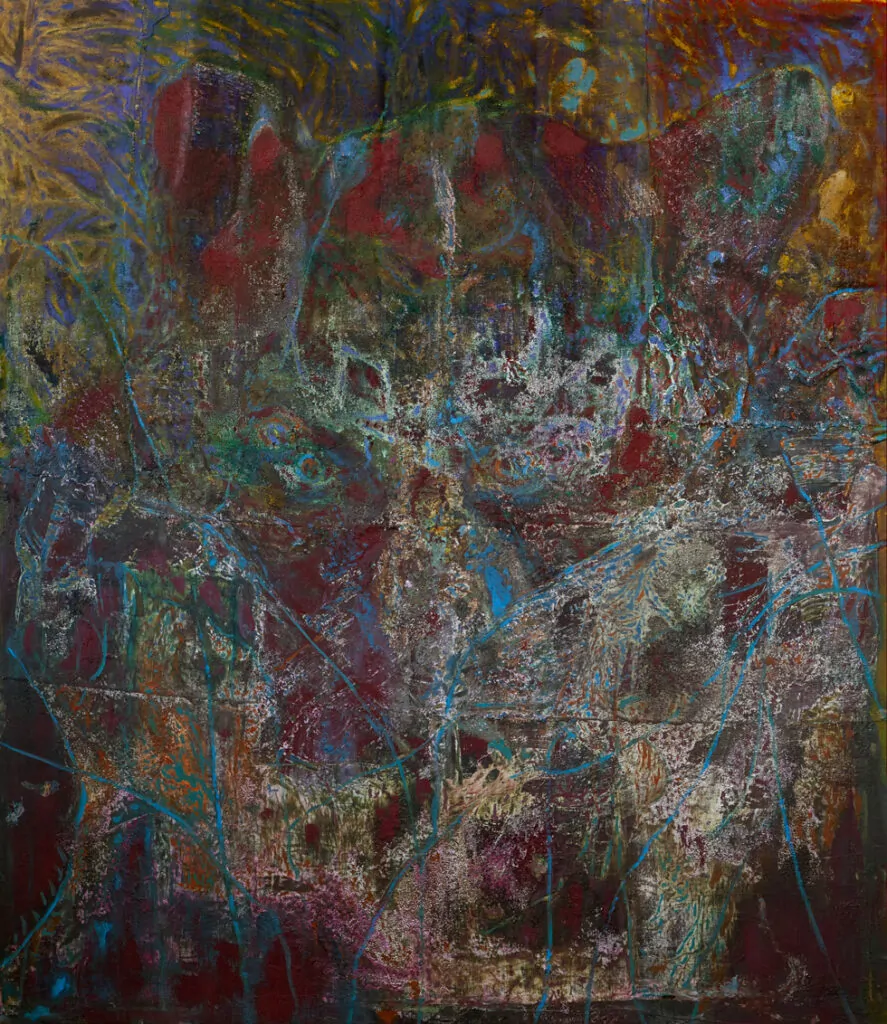
Father Bear, 2024
mixed media with glass beads on canvas and burlap
193 x 167.6 cm | 76 x 66 in (AE/10)
Courtesy of the artist and MARUANI MERCIER
Although I needed to go through the same process of grief and disillusionment as when I left the church, I also needed to come to a place where I could understand that, to a large extent, my feeling of rejection by the culture, was also my rejection of the culture. This rejection wasn’t conscious, but simply felt in my body as depression and back pain and so on. I thought I was meant to belong to something, but, on a soul level, I’ve simply never been much of a joiner.
And that’s where I was when we landed in New Mexico: split, depressed, and broke. It was the start of a long process of what I call “repatriating the soul.” New Mexico is the first place since my earliest childhood that I have a sense of home. This deep sense of relatedness that I experience here isn’t to do with any particular social reality as it is with the physical reality of New Mexico itself, the landscape. It’s here that I began to seek wholeness, developed a meditation practice, and, little by little, surrender the shallower images I’ve associated with identity, specifically my identity. The immediate physical world constitutes a larger proportion of my own inner life than at any previous time in life.
To come all the way back to your original question—how has all of this informed my vision—absolutely and totally. It has brought me to the a place inwardly where I attend to the visions that I get. At 45, I’ve had time to develop kind of of retrospective cohesion to the way in which I came of age and developed as an artist. It informs not just the work that I do, but how I fundamentally understand what art is, what it’s for, and to accept my own sense of fatedness that comes with that. I am getting better at accepting time’s strange movements and its mystery, and, therefore, better at accepting myself.
New Mexico is the first place I’ve lived that feels like a part of who I am, and yet spreads out in every direction far beyond grasping. If, in the past, my creative life often proceeded from out of what was culturally forbidden in the hope that I might become acceptable to that culture and to myself, nowadays the creative life is lifted up in the abundance and affordances that the very real physical world makes available every day. There really isn’t anyone around, aside from my wife (hers is the only opinion I care about), to say whether the work is acceptable. As someone who doesn’t really trust consensus, I’m not waiting around for the answer. There probably isn’t one I would believe.
The Glass Dream Game feels both personal and scholarly, mystical and methodical. How do you reconcile the sacred and the profane in your work?
Æmen Ededéen (Joshua Hagler): I don’t reconcile them. It’s not for me to say which is which. Ultimately, I think that’s a distinction the viewer makes, if any distinction is made.
You’ve adopted the name Æmen Ededéen for this presentation. Is this a conceptual persona, a pseudonym, or a new phase in your artistic evolution?
Æmen Ededéen (Joshua Hagler): Æmen is my name, whether working on this project or any other. It’s a name I’ve kept tucked away in my back pocket for about ten years but was afraid to wear. When Nihil concluded, I didn’t want to wear my birth name anymore. I felt I had actualized something internally, which was to do with me individually but also with the hidden world, which transcends any specific self. It is, of course, a persona but so was Joshua Hagler. That’s what names afford us.
Your work doesn’t shy away from difficult subjects—religious identity, American extremism, moral binaries. How do you approach these themes without becoming didactic?
Æmen Ededéen (Joshua Hagler): Actually I think the work’s difficulty is that it isn’t didactic. All subjects are difficult at the moment you actually begin looking at them. Looking closely at anything always reveals itself to be other than what you thought it was. There is something there, in flux, non-static, and, at the same time, it is no-thing. That seems to frighten people.
Do you consider your paintings to be about meaning—or about the failure, or instability, of meaning itself?
Æmen Ededéen (Joshua Hagler): Well, when we talk about painting, we’re really talking about an encounter of some kind—an encounter with an indescribable aspect of reality, both within and outside ourselves. There’s certainly a sense of meaningfulness in the act of painting, in being attentive and open to those moments when the painting reveals something I wasn’t expecting—something visible that intimates something invisible.
It’s probably more important that the painting is something than that it means something. I tend to find the doing and being of things more meaningful than the pointing at and talking about them. There are two very different games at play there, and I often wonder how closely related they actually are.
That said about painting, The Glass Dream Game—of which painting is just one component—is really an ongoing experiment rooted in the question of meaning.
In the basic structure of the Game, what follows the Hexagram is called the Trial. This is where I look for all the patterns and connections I can find. Sometimes these relate to events in my personal life; other times, they reflect things happening in the world—often it’s both. From there, I have a basic kind of construction: I’m organising the gestalt, laying it out on the operating table, so to speak.
From the Trial, I move to the Dream. This is where I construct a narrative based on what I see in the “runes,” so to speak. The Dreams are written from wildly different points of view, as though told by different people or characters, unfolding in a sequence I refer to as Movements.
Out of the Dream comes the Vision. The Vision is the painting—the visualisation of elements I’ve found in the Dream. The painting is never directly about the Dream; the Visions are not illustrations of the text. They simply offer another dimension to the Game.
When all four parts—Hexagram, Trial, Dream, and Vision—come together, they form something I take seriously, something that belongs to contemplative life. I think of it as an almost occult form of watching and listening. I don’t know exactly what it means to play the Game, but I experience its reality and value in my daily life. It seems to be a way of marking inner transformation.
In that sense, meaning—or what we make of meaning—is necessarily unstable. If it were static, it would suggest our lives had become static too, that we’d stopped believing in the possibilities of the world and our role within it. But a game is a form of play—in my case, play with meaning itself. To play with meaning, it seems to me, is a good way to live. Not to believe or disbelieve, but simply to encounter possibilities and wait for the right moment to act.
©2025 Æmen Ededéen (Joshua Hagler)


